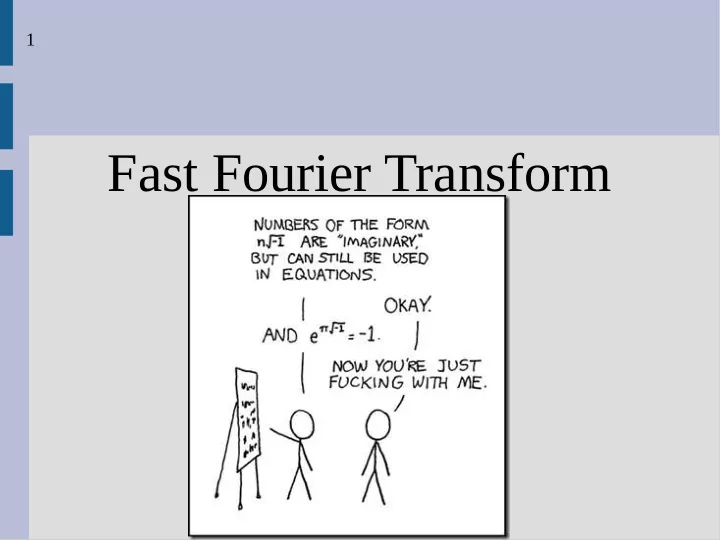

1 Fast Fourier Transform
2 Announcements HW 3 posted tonight (after this)
3 Fast Fourier Transform
4 Math ground work Let Called “n th roots of unity” We will prove/use:
5 Math ground work Prove: By definition: Prove: Again, by definition:
6 Math ground work Prove: A geometric sum is known to be: ... thus: k not divisible by n, denominator ≠ 0
7 Math ground work Prove: Direct proof: (using proof #1) Picture proof: Thus, twice the angle
8 Fast Fourier Transform First, we need to efficiently go from coefficient to point form (n is even) We will use the n roots of unity for xs
9 Fast Fourier Transform We can use the symmetry of the unity roots to divide & conquer: First we break even and odd indexed coefficients into their own polys
10 Fast Fourier Transform We then notice that: Thus:
11 Fast Fourier Transform By proof #4, computing A() as: ... breaks down the problem into: two parts, each with half the points (as squaring nth unity roots gives n/2 unity roots)
12 Fast Fourier Transform By following this process, we get the following tree: A(x) A [1] A [0]
13 Fast Fourier Transform Recursive-FFT(a) n = a.length (n assumed power of 2) if (n == 1), return a w n = e 2πi/n , w = 1 a[0] = (a 0 , a 2 , ... a n-2 ), a[1] = (a 1 , a 3 , ... a n-1 ) y[0] = Recursive-FFT(a[0]) y[1] = Recursive-FFT(a[1]) for k = 0 to n/2 - 1 y k = y[0] k + w * y[1] k y k+(n/2) = y[0] k - w * y[1] k w = w * w n return y
14 Fast Fourier Transform For loop runs O(n) times with O(1) work inside each loop 2 recursive calls each size n/2, thus...
15 Fast Fourier Transform The first line of loop computes: Similarly, the second finds: proof #2
16 Fast Fourier Transform Suppose.... A(x) = (x+1) B(x) = (x 2 - 2x + 3) The A(x)*B(x) will be degree 3 (thus 4 coefficients) So 4 points needed on A(x) and B(x)
17 Fast Fourier Transform To do this we buffer some “0” coefficients: A(x) = (x+1) = (0x 3 + 0x 2 + x + 1) So coefficients (from power 0) = [1 1 0 0] From this we can run FFT
18 Fast Fourier Transform just did last time did ... =(
19 Fast Fourier Transform If you remember from last time, we want to solve for y's in: y V (x's) a
20 Fast Fourier Transform To solve for a's in previous, we use the math magic below! Due to unity root magic
21 Fast Fourier Transform Proof: (that this is V -1 ) Using proof #3, if j ≠ k then this is 0 When j = k, we have
22 Fast Fourier Transform Wait, a second... we basically just solved y = V a, with Now we want to solve (knowing y not a) a = V -1 y, with This is a very similar problem!
23 Fast Fourier Transform swap y and a Recursive-FFT-backwards(y) n = y.length (n assumed power of 2) if (n == 1), return y only added “-” to exponent w n = e -2πi/n , w = 1 y[0] = (y 0 , y 2 , ... y n-2 ), y[1] = (y 1 , y 3 , ... y n-1 ) a[0] = Recursive-FFT-backwards(y[0]) a[1] = Recursive-FFT-backwards(y[1]) for k = 0 to n/2 - 1 a k = a[0] k + w * a[1] k after recursion, a k+(n/2) = a[0] k - w * a[1] k w = w * w n divide a by n in main return a
25 Fast Fourier Transform Breaking down A(x) into A [0] (x) and A [1] (x) gives: If we can get a i in order of the bottom we can efficiently compute A
26 Fast Fourier Transform Consider the order: [a 0 , a 4 , a 2 , a 6 , a 1 , a 5 , a 3 , a 7 ] See a pattern?
27 Fast Fourier Transform Consider the order: [a 0 , a 4 , a 2 , a 6 , a 1 , a 5 , a 3 , a 7 ] See a pattern? ... what if I write it as: [000,100,010,110,001,101,011,111] These are just the bits inversed
28 Fast Fourier Transform Thus, if we initially swap the coefficient matrix in this order... 1. We can update the value in place 2. Each level of the tree, we compare coefficients twice as far as the previous
29 Fast Fourier Transform Thus we can compute it iteratively as: Good for parallel processing?
30 Fast Fourier Transform This works well for a circuit, but not so much for multi-core The processes need to wait until all previous level done to continue
31 Fast Fourier Transform It might work just as well (or better) to parallelize the recursive calls cpu #2 solves cpu #1 solves Easy ~2x speed up!
Recommend
More recommend